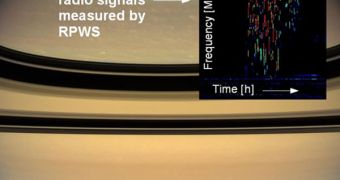The large gas giant Saturn now holds yet another record, this time for the longest storm ever recorded in the solar system. It began to form in the planet's atmosphere in January, which means that it has been ongoing for the past eight months. A similar formation was observed on Saturn between November 2007 and July 2008, which lasted for 7.5 months, as evidenced by the Cassini spacecraft, in orbit around the planet. Since 2004, when the NASA/ESA orbiter reached its destination, nine large storms have been observed on Saturn, Space reports.
The Radio and Plasma Wave Science (RPWS) instrument aboard Cassini is mostly responsible for collecting information about the storms that take place on the planet. Lightnings in the 1,900-mile (3,000-kilometer) storms emit radio waves that are up to 10,000 times stronger than those back on Earth. They are very easily picked up by the orbiter's sensitive instruments, processed, and then data about them is relayed back to the mission control. Details of the latest, record-setting storm will be presented today at the European Planetary Science Congress, held in Potsdam, Germany.
“These lightning storms are not only astonishing for their power and longevity, the radio waves that they emit are also useful for studying Saturn's ionosphere, the charged layer that surrounds the planet a few thousand kilometers above the cloud tops. The radio waves have to cross the ionosphere to get to Cassini and thereby act as a natural tool to probe the structure of the layer and the levels of ionization in different regions,” Austrian Academy of Sciences expert Georg Fischer, who will detail the event at the conference, explained before the presentation.
Most thunderstorms on the planet form in a region known as the “Storm Alley,” located some 35 degrees South of the equator. “The reason why we see lightning in this peculiar location is not completely clear. It could be that this latitude is one of the few places in Saturn's atmosphere that allow large-scale vertical convection of water clouds, which is necessary for thunderstorms to develop. However, it may be a seasonal effect. Voyager observed lightning storms near the equator, so now that Saturn has passed its equinox on August 11th, we may see the storms move back to equatorial latitudes,” he added.

 14 DAY TRIAL //
14 DAY TRIAL //